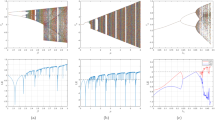Abstract
Recently, a stream encryption scheme using d-bit segment sequences has been proposed. This scheme may generate key avalanche effect. The randomness tests of d-bit segment pseudorandom number generator will be important for implementing such a scheme. Firstly this paper extends Beker and Piper’s binary pseudorandom sequence statistical test suite to d-bit segment sequences case. Secondly, a novel 3-dimensional polynomial discrete chaotic map (3DPDCM) is proposed. The calculated Lyapunov exponents of the 3DPCDM are 0.213, 0.125 and − 3.228. Using the 3DPDCM constructs a 6-dimensional generalized synchronization chaotic system. Based on this system, a 8-bit segment chaotic pseudorandom number generator (CPRNG) is introduced. Using the generalized test suite tests 100 key streams generated via the 8-bit PRNG with different initial conditions and perturbed system parameters. The tested results are similar to those of the key streams generated via RC4 PRNG. As an application, using the key streams generated via the CPRNG and the RC4 PRNG encrypts an RGB image Landscape. The results have shown that the encrypted RGB images have significant avalanche effects. This research suggests that the requirements for PRNGs are not as strict as those under the traditional avalanche criteria. Suitable designed chaos-based d-bit string PRNGs may be qualified candidates for the stream encryption scheme with avalanche effect.
Similar content being viewed by others
References
C.L. Phillips, J.A. Anderson, S.C. Glotzer, J. Comput. Phys. 230, 7191 (2011)
N. Ferguson, B. Schneier, T. Kohno, Cryptography Engineering: Design Principles and Practical Applications (Wiley Publishing, 2010)
S. Banerjee, Chaos Synchronization and Cryptography for Secure Communications: Applications for Encryption (IGI Global, 2010)
G. Marsaglia, Diehard test suite, 1996, http://www.stat.fsu.edu/pub/diehard/
NIST, FIPS PUB 140-2, security requirements for cryptographic modules (NIST, Gaithersburg, MD, 2001)
A. Rukhin, J. Soto, J. Nechvatal, et al., A Statistical Test Suite for Random and Pseudorandom Number Generator for Cryptographic Applications (NIST Special Publication, 2001)
P.L. Ecuyer, R. Simard, ACM Trans. Math. Software 33, 1 (2007)
H. Beker, F. Piper, Cipher systems: the protection of communications (van Nostrand Reinhold, New York, 1982)
J.G. Spropt, Chaos and Time-Series Analysis (University Press, Oxford, 2003)
R.A.J. Matthews, Cryptologia XIII(1), 29 (1989)
T. Stojanovski, L. Kocarev, IEEE Trans. Circ. Syst.-I: Fund. Theory Appl. 48, 281 (2001)
B. Nana, P. Woafo, S. Domngang, Comm. Nonlinear Sci. Numer. Simul. 14, 2266 (2009)
F. Sun, S. Liu, Chaos, Solitons Fractals 41, 2216 (2009)
D.V. Senthilkumar, J. Kurths, Eur. Phys. J. Special Topics 187, 87 (2010)
J.W. Yoon, H. Kim, Comm. Nonlinear Sci. Numer. Simul. 15, 3998 (2010)
P. Shyamala, Comm. Comput. Info. Sci. 140, 312 (2011)
A. Akhavan, A. Samsudin, A. Akhshani, J. Franklin Inst. 348, 1797 (2011)
S. Banerjee, S. Mukhopadhyay, Opt. Lasers Eng. 50, 950 (2012)
A. Kanso, M. Ghebleh, Commun. Nonlinear Sci. Numer. Simulat. 17, 2943 (2012)
S. Banerjee, M.R.K. Ariffin, Optics Laser Technol. 45, 435 (2013)
S.J.S. Theesar, M.R.K. Ariffin, S. Banerjee, Optics Laser Technol. 54, 15 (2013)
C.K. Volos, I.M. Kyprianidis, I.N. Stouboulos, Signal Proc. 93, 1328 (2013)
J.S.A.E. Fouda, J.Y. Effa, S.L. Sabat, et al., Commun. Nonlinear Sci. Numer. Simulat. 19, 578 (2014)
A. Kassem, H.A.H. Hassan, Y. Harkouss, Digital Signal Proc. 25, 266 (2014)
L. Min, G. Chen, Euro. Phys. J. B 86, 459-1 (2013)
L. Min, L. Hao,L. Zhang, Study on the Statistical Test for String Pseudorandom Number Generators, in Lecture Notes Artificial Intelligence, edited by D. Liu, et al., Vol. 7888 (Springer-Verlag, Berlin, 2013), p. 278
S.W. Golomb, Shift Register Sequences (Laguna Hills, Aegean Park, CA, 1982)
A. Menezes, P. Vanorschot, S. Vanstone, Handbook of Applied Cryptography (CRC Press, 1996)
H. Zang, L. Min, G. Zhao, A generalized synchronization theorem for discrete-time chaos system with application in data encryption scheme, in Proc. of the 2007 Int. Conf. on Communications, Circuits and Systems, Vol. II (Kokura, Fukuoka, Japan, 2007), p. 1325
L. Min, G. Chen, Int. J. Bifurcat. Chaos 23, 1350016-1 (2013)
Author information
Authors and Affiliations
Corresponding author
Rights and permissions
About this article
Cite this article
Hao, L., Min, L. Statistical tests and chaotic synchronization based pseudorandom number generator for string bit sequences with application to image encryption. Eur. Phys. J. Spec. Top. 223, 1679–1697 (2014). https://doi.org/10.1140/epjst/e2014-02182-2
Received:
Revised:
Published:
Issue Date:
DOI: https://doi.org/10.1140/epjst/e2014-02182-2




